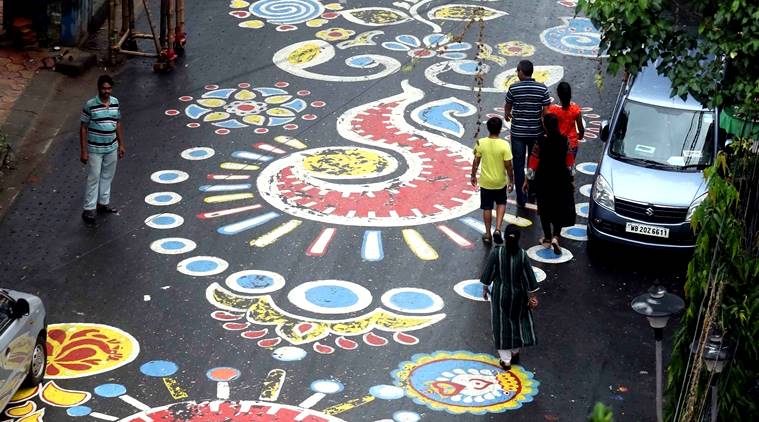Alpona: Food for the ants and an antiseptic
Durga Puja 2018: Bengal’s floor art, alpona, is more than just a pretty art form.

Alpona is a traditional, ritualistic floor drawing, popular in Bengal and continues to be an integral part of all celebrations. (Express photo by Partha Paul)
It is mostly during festivals such as Durga Puja that we get to witness beautifully designed and decorated floor art that adds to the mood of the celebrations. In Bengal and Assam, this floor art is called alpona, aripana in Bihar, pakhamba in Manipur, jinnuti in Orissa, mandana in Rajasthan, rangoli in Maharashtra, likhnu in Himachal Pradesh, apna in Almora and Nainital region, kolam in Tamil Nadu, and muggulu in Andhra Pradesh – together, they form a part of a rich folk art genre.
Practised by drawing geometrical or free-hand motifs on the floor, it’s a fairly laborious art form. Highly popular though, it was just last year that the longest ever alpona was drawn in Kolkata’s Salt Lake City.
It is interesting to note that originally, floor painting was practised in many cultures throughout the world – be it Tibet’s mandala paintings or the dot paintings by Australian aboriginals. India is one of the few countries where this tradition of practising floor art on a daily basis has survived and it is mostly the women who should be credited for keeping this folk art alive.
Traditional roots
Alpona is a traditional, ritualistic floor drawing, popular in Bengal and continues to be an integral part of all celebrations – be it pujas or weddings. The word finds its roots in the Sanskrit word, “alimpan” which means “to coat”.
Traditionally, alpona is supposed to be made using a water-based paste made from uncooked rice kernel of unprocessed sun-dried paddy called ‘aatop chaal’ which is diluted to the consistency of thick milk. A cotton ball or a small piece of fine cloth is dipped in the liquid mixture and pressed in between the fingers gently so that the liquid flows evenly as one draws the motifs. The traditional Bengali alpona is white in colour and fashioned by women into various geometrical or freehand motifs of flowers, trees, animals, humans, etc.
According to Rabi Biswas, a practitioner and researcher on the art form, “Alpona was originally performed in villages by the girls to decorate the door-fronts, floors and the places before the idols of deities. Initially, alpona saw the use of motifs of paddy leaf, feet of Goddess Laxmi, lotus and other images which were meant for welcoming wealth into the house. But now it experiments with a large variety of designs which are growing out of its intrinsic aesthetic properties.”
Importance of the art form for the women in the community
In Bengal, women observe brotos (or vratas) on various occasions, which requires them to follow the ritual of drawing alpona. Earlier, the Bhaduli broto, which is usually observed post-monsoon, saw women drawing motifs on the floor to ensure the safe return of their husbands after travelling long distances in the rain.
Practising art is often therapeutic and this form not only gave women an opportunity to express themselves but also brought them closer as a community. Women would often get together to create the floor art and apart from finding an outlet to express themselves, they also found companions to share a hobby with.
Biswas believes that “the social decoration and ritual part also plays a great role in the life of the communities at large. These communities also decorate their house, pathways, banks of the river by holding rags in their palms and making designs with their fingers”. The very fact that alpona is drawn using rice flour, also means that earlier it also served as bhutayajna, that is, an offering of rice flour to tiny creatures like ants and other insects as one’s good deed of the day. Rice powder is also a cleansing element preventing chicken pox during the coming summer and is therefore applied on the faces of children in rural southern India. Some alponas also see the use of yellow colour that comes from turmeric, a powerful antiseptic since ancient times.
Much of this wisdom and tradition has now been lost to time. Alpona is an art form which thrives on the knowledge passed down from one generation to the other. Very few people offer to teach this form of art formally. It comes alive only during major festivals and like the ephemeral nature of the art, it pays us a visit only for a very short period of time. For an art form that brings the community together and celebrates togetherness, one can only hope that this folk art will be practised for many decades to come.






















No hay comentarios:
Publicar un comentario